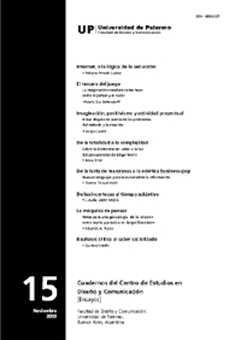La máquina de pensar
Abstract
The delineation of Eisensteins esthetic and poetic and his relation with the Russian formalists constitute
the axis of the essay. The relations between the thinking and the making, between the theory and the
praxis place Eisensteins filming as an attempt of thinking on images the developed concepts in a communal manner by the mentioned formalism. The author defines the eisenstenian subject as a
reflexive one. Making a film od watching a film would not be more that another step in the way of
thinking. From this optic the analysis of Eisensteins filming it is faces from topics like the montage, the
idea of the tipaz, the screen as an emotional icon, of the musical analogy, etc., in a space that goes from the initial formalism to Eisensteins work in the Stalinism background.
References
Aumont, Jacques (1987), Montage Eisenstein, Bloomington, Indiana University Press.
Bordwell, David (1993), The Cinema of Eisenstein, Cambridge, Ma.-London, Harvard University Press.
Eisenschitz, Bernard. y Grinbaum, Blanche (1993), Les avant-gardes des années 20 en AA. VV. Cinéma russe et soviétique, Paris, Ed. Centre Pompidou.
Eagle, Herbert (1981), Russian Formalist Film Theory, Michigan, Slavonic Studies.
Eisenstein, Sergei (1949), Film Form, New York, Harcourt&Brace.
Eisenstein, Sergei (1970), El sentido del cine, México, Siglo XXI.
Eisenstein, Sergei (1976), La non-indiferente nature, París, UGE.
Jameson, Fredric (1972), The Prison-House of Language, Princeton, Princeton University Press.
Sklovski, Victor (1972), Eisenstein, Barcelona, Anagrama.
Sklovski, Victor (1973), La disimilitud de lo similar los orígenes del formalismo, Madrid, Alberto Corazón.
Thompson, Kristin (1988), Breaking the Glass Armor, Princeton, Princeton University Press,
Todorov, Tzvetan (1973), Teoría de la literatura de los formalistas rusos, México, Siglo XXI.
Todorov, Tzvetan (1994) Crítica de la crítica, Barcelona, Paidós.
Vigotsky, Lev (1962), Pensamiento y lenguaje, Buenos Aires, Siglo XXI.
Los autores/as que publiquen en esta revista ceden los derechos de autor y de publicación a "Cuadernos del Centro de Estudios de Diseño y Comunicación", Aceptando el registro de su trabajo bajo una licencia de atribución de Creative Commons, que permite a terceros utilizar lo publicado siempre que de el crédito pertinente a los autores y a esta revista.


